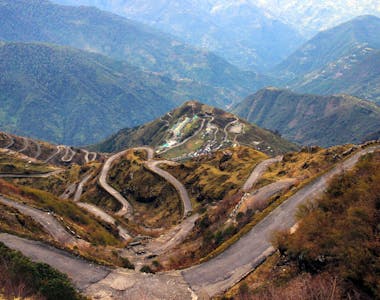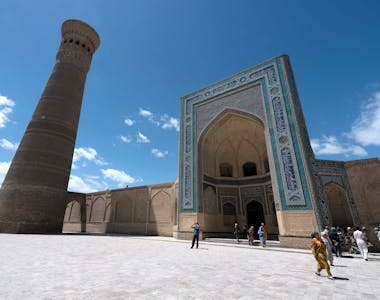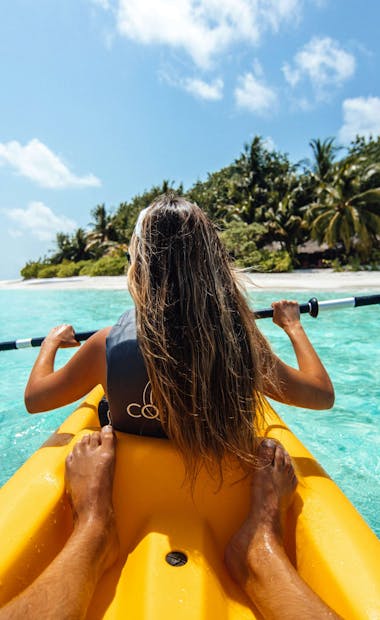
The Silk Road
Where East meets West. Exploring the magical ancient trade route
Popular tours
- Save24%
 View Tour
View TourSultans & Silk Road - 10 Days
- Istanbul to Istanbul
- Age group: 8 - 99
- Max group size: 20
Was:£2,690From£2,036 - Save20%
 View Tour
View TourKyrgyzstan's Silk Road Journey - 14 Days
- Bishkek to Tashkent
- Age group: 16 - 79
- Max group size: 16
Was:£2,295From£1,827 - Save20%
 View Tour
View TourWonders of the Silk Road - 13 Days
- Ashgabat to Tashkent
- Age group: 16 - 79
- Max group size: 16
Was:£2,285From£1,819 - Save20%
 View Tour
View TourThe Silk Road of Uzbekistan - 11 Days
- Tashkent to Tashkent
- Age group: 16 - 79
- Max group size: 16
Was:£1,545From£1,230 - Save20%
 View Tour
View TourThe Three Stans of The Silk Road - 15 Days
- Bishkek to Samarkand
- Age group: 16 - 79
- Max group size: 16
Was:£2,835From£2,257  View Tour
View TourJourneys: Echoes of the Silk Road - 23 Days
- Bishkek to Ashgabat
- Age group: 12 - 100
- Max group size: 16
Was:£5,649From£5,621
Travel The Silk Road
Welcome to the Silk Road, an ancient network of trade routes that connected the East and West, spanning over thousands of kilometres and traversing diverse landscapes and cultures. Embark on a remarkable journey as you visit the Silk Road, immersing yourself in its rich history, breath-taking landscapes, and vibrant cultures. Our small guided tours offer an immersive and authentic experience, allowing you to discover the wonders of this legendary route.
The best time to visit the Silk Road depends on the specific regions and activities you plan to explore. Generally, spring (April to June) and autumn (September to November) offer pleasant temperatures and milder weather, making them popular seasons for travel. Summers can be hot, particularly in the desert regions, while winters can be cold and snowy in some areas. It's advisable to check the specific weather conditions of the regions you plan to visit and choose a time that suits your preferences.
Highlights of the Silk Road:
Historic Cities: Explore ancient cities such as Xi'an, Dunhuang, Samarkand, Bukhara, and Kashgar, which served as important trading hubs along the Silk Road. Marvel at well-preserved relics, stunning architecture, and UNESCO World Heritage Sites.
Cultural Encounters: Engage with local communities and witness their unique traditions, arts, and crafts. Interact with artisans, visit traditional bazaars, and gain insights into the diverse cultures that thrived along the Silk Road.
Natural Wonders: Experience the awe-inspiring landscapes along the route, from the majestic Tian Shan Mountains to the vast Taklamakan Desert and the stunning Pamir Mountains. Discover hidden oases, picturesque valleys, and breathtaking vistas.
Historical Sites: Visit ancient ruins, fortresses, and archaeological sites that testify to the historical significance of the Silk Road. Explore the Mogao Caves, the Terracotta Warriors and Horses, the Registan Square, and many other captivating sites.
Culinary Delights: Indulge in a culinary adventure, savoring the flavors of the Silk Road. Sample traditional dishes influenced by the diverse cultures along the route, including Uighur, Uzbek, Kazakh, and Chinese cuisines.
Planning Your Visit:
Guided Tours: Our small guided tours provide you with expert guides who are knowledgeable about the Silk Road's history, culture, and traditions. They ensure a seamless and enriching experience, offering insights and taking care of logistics.
Itineraries: Our carefully curated itineraries cover the must-see attractions along the Silk Road while allowing for immersive cultural experiences and interactions. We also provide flexibility, allowing you to customize your itinerary based on your interests and preferences.
Accommodation: Enjoy comfortable accommodations that blend modern amenities with a touch of local charm. Stay in carefully selected hotels, guesthouses, or even traditional yurts, depending on the regions you visit.
Transportation: Travel in comfort with reliable transportation options, including private vehicles, trains, and domestic flights. Sit back, relax, and let our experienced drivers and guides take care of the logistics.
Authentic Experiences: We strive to provide authentic and meaningful experiences that connect you with the local culture and communities. From attending traditional performances to participating in local festivals or workshops, we offer opportunities for immersive engagement.
Visiting the Silk Road is like stepping back in time, tracing the footsteps of ancient traders and explorers. It's an adventure that combines history, culture, natural beauty, and unforgettable experiences. Join our small guided tours and embark on a once-in-a-lifetime journey along the legendary Silk Road.
What Is The Silk Road?
The Silk Road refers to an ancient network of trade routes that connected the East and West. It was a network of overland and maritime routes that spanned from China across Central Asia, the Middle East, and Europe. The Silk Road played a crucial role in facilitating cultural exchange, economic growth, and the spread of ideas between different civilizations.
There are several reasons why people are drawn to visit the Silk Road:
Historical Significance: The Silk Road was a vital trade route for centuries, enabling the exchange of goods, technologies, and ideas between diverse cultures. Exploring the Silk Road allows travellers to immerse themselves in its rich historical heritage and witness the remnants of ancient civilizations.
Cultural Diversity: The Silk Road was a melting pot of different cultures, religions, and languages. Traveling along this route offers a unique opportunity to encounter diverse ethnic groups, experience their traditions, taste their cuisines, and appreciate their arts and crafts.
Architectural Marvels: Along the Silk Road, you'll encounter magnificent architectural wonders, including ancient cities, fortresses, palaces, temples, and mosques. These structures exhibit a blend of various architectural styles and serve as a testament to the cultural and artistic achievements of the civilizations that thrived along the route.
Stunning Landscapes: The Silk Road traverses a variety of landscapes, from arid deserts to lush oases, snow-capped mountains, and fertile valleys. Travelers can witness breath-taking natural beauty, including the Gobi Desert, Pamir Mountains, Tian Shan Mountains, and the Taklamakan Desert.
Adventure and Exploration: The Silk Road offers a sense of adventure and exploration as you follow in the footsteps of ancient traders and explorers. It provides opportunities for trekking, camel rides, desert safaris, and experiencing the nomadic way of life.
Unique Souvenirs and Shopping: Along the Silk Road, you'll find bustling bazaars and markets where you can shop for traditional crafts, textiles, spices, carpets, jewellery, and other unique souvenirs. These markets offer an authentic and vibrant shopping experience.
Spiritual and Pilgrimage Sites: The Silk Road is home to numerous sacred sites and pilgrimage destinations associated with various religions, including Buddhism, Islam, and Christianity. Travelers interested in spirituality and religious history can visit temples, monasteries, mausoleums, and holy sites.
Visiting the Silk Road provides a remarkable opportunity to explore the interconnections between civilizations, discover ancient history, experience diverse cultures, and witness awe-inspiring landscapes. It's a journey that offers a deep understanding of our shared human heritage and the enduring legacy of the Silk Road.
Where Is the Silk Road?
The Silk Road was a vast network of trade routes that spanned several regions, connecting the East and West. It traversed various countries and territories, including:
East Asia: The Silk Road originated in China, particularly from cities like Xi'an and Chang'an (modern-day Xianyang), which served as major starting points. Chinese silk, porcelain, tea, and other goods were transported westward along the route.
Central Asia: The Silk Road passed through several Central Asian countries, including Kazakhstan, Kyrgyzstan, Tajikistan, Uzbekistan, and Turkmenistan. These countries were important hubs for trade and cultural exchange.
South Asia: The Silk Road extended into parts of South Asia, specifically through regions of present-day Afghanistan, Pakistan, and India. Cities like Kabul, Peshawar, and Lahore were significant centers along the route.
The Middle East: The Silk Road entered the Middle East, encompassing countries such as Iran, Iraq, Syria, Jordan, and Lebanon. Major cities like Tehran, Baghdad, Damascus, and Aleppo played vital roles in facilitating trade and cultural interchange.
Eastern Mediterranean: The Silk Road reached the eastern Mediterranean region, including present-day Turkey, Greece, and Egypt. Cities like Istanbul (formerly Constantinople) and Alexandria were important trading centers.
Europe: The Silk Road extended into Europe, particularly through regions of present-day Russia, Ukraine, and the Balkans. Cities like Samarkand, Bukhara, Tashkent, Istanbul, Venice, and Rome were significant destinations along the route.
It's important to note that the Silk Road consisted of multiple branches and routes, with variations depending on different historical periods and trade preferences. The exact path and destinations along the Silk Road varied over time, but the general concept of connecting the East and West remained consistent.
Today, travelers can visit various cities, archaeological sites, and historical landmarks along the Silk Road, experiencing the diverse cultures, stunning landscapes, and rich history of the regions it encompasses.
Which countries does the Silk Road cover?
The Silk Road covers several countries across Asia, Europe, and the Middle East. The specific countries included in the Silk Road route can vary depending on different interpretations and historical periods. However, here are some of the key countries commonly associated with the Silk Road:China: The Silk Road originated in China and traversed various cities and regions, including Xi'an, Dunhuang, Turpan, and Kashgar.
Kazakhstan: The Silk Road passed through southern Kazakhstan, with notable cities like Almaty and Turkestan along the route.
Kyrgyzstan: The Silk Road route crosses parts of Kyrgyzstan, including cities like Osh and Karakol.
Tajikistan: The Pamir Mountains in Tajikistan played a crucial role in Silk Road trade, with cities like Khujand and Dushanbe.
Uzbekistan: Uzbekistan is home to several significant Silk Road cities, including Samarkand, Bukhara, and Khiva.
Turkmenistan: The Silk Road route extends through Turkmenistan, with cities like Merv and Ashgabat.
Iran: Iran played a vital role as a crossroads for the Silk Road, with cities like Tehran, Isfahan, and Mashhad along the route.
Turkey: The Silk Road reached its western terminus in Turkey, with cities like Istanbul and Cappadocia serving as important trading hubs.
It's important to note that the Silk Road had multiple branches and alternate routes, and there were many other countries and regions that were indirectly influenced by its trade and cultural exchange. The countries mentioned above represent some of the most prominent locations associated with the historic Silk Road network.
When visiting the Silk Road what should I expect?
When visiting the Silk Road, you can expect a captivating journey through history, culture, and diverse landscapes. Here are some things to expect when exploring the Silk Road:
Rich Cultural Heritage: The Silk Road has witnessed the exchange of ideas, religions, languages, and traditions. You can expect to encounter a fascinating mix of cultures, including Chinese, Central Asian, Persian, Indian, and European influences. Explore ancient cities, architectural wonders, UNESCO World Heritage Sites, and museums that showcase the region's vibrant history.
Historic Sites and Landmarks: The Silk Road is dotted with remarkable historical sites and landmarks. Visit iconic destinations such as the Terracotta Army in Xi'an (China), Samarkand's Registan Square (Uzbekistan), the ancient city of Palmyra (Syria), the ruins of Persepolis (Iran), and the historic city of Istanbul (Turkey). These sites offer a glimpse into the past and showcase the architectural and artistic achievements along the Silk Road.
Stunning Landscapes: The Silk Road spans diverse landscapes, ranging from deserts and mountains to fertile valleys and rivers. Expect to encounter breathtaking scenery as you traverse the route. Marvel at the rugged landscapes of the Pamir Mountains, explore the vast deserts of the Taklamakan and Gobi, and discover the oases and fertile plains that sustained travelers and merchants along the way.
Local Markets and Bazaars: Experience the vibrant trading culture that characterized the Silk Road by visiting local markets and bazaars. Explore bustling marketplaces where you can find traditional crafts, textiles, spices, and local products. Immerse yourself in the lively atmosphere, interact with local vendors, and indulge in the flavors of the region.
Culinary Delights: The Silk Road offers a tantalizing culinary journey. Sample a diverse array of dishes influenced by the various cultures along the route. Taste aromatic spices, hearty Central Asian cuisine, flavorful Persian dishes, and delicate Chinese flavors. From dumplings and kebabs to pilaf and tea ceremonies, the Silk Road will delight your taste buds.
Hospitality and Warmth: Along the Silk Road, you will encounter warm hospitality from the local communities. Experience the kindness and generosity of the people who have preserved the traditions and heritage of the region. Engage with locals, stay in traditional guesthouses, and learn about their way of life.
Adventure and Exploration: Traveling the Silk Road is an adventure in itself. Whether you choose to explore the route by train, overland journey, or guided tours, expect to immerse yourself in a captivating and transformative experience. Embrace the spirit of adventure as you follow in the footsteps of ancient traders and explorers.
Visiting the Silk Road offers a unique opportunity to connect with history, immerse yourself in vibrant cultures, and witness the enduring legacy of this ancient trade route. It is a journey that will leave you with unforgettable memories and a deeper understanding of the interwoven tapestry of civilizations along the Silk Road.
What are the must-visit attractions along the Silk Road?
The Silk Road is rich in cultural, historical, and natural attractions. Here are some must-visit attractions along the Silk Road:
The Terracotta Army (China): Located near Xi'an, the Terracotta Army is an impressive collection of thousands of life-sized statues depicting the armies of China's first emperor, Qin Shi Huang.
Mogao Caves (China): Situated near Dunhuang, the Mogao Caves are a UNESCO World Heritage site containing Buddhist cave temples adorned with intricate murals and sculptures.
Samarkand (Uzbekistan): Known for its stunning Islamic architecture, Samarkand features iconic sites such as the Registan Square, Shah-i-Zinda, and the mausoleum of Tamerlane.
Bukhara (Uzbekistan): Another UNESCO World Heritage site, Bukhara is famous for its well-preserved historic center, featuring ancient mosques, madrasas, and trading domes.
Khiva (Uzbekistan): Step into a well-preserved medieval oasis in Khiva, with its UNESCO-listed old town, Ichan-Kala, filled with exquisite palaces, mosques, and minarets.
Persepolis (Iran): A UNESCO World Heritage site, Persepolis is an ancient city of the Persian Empire, featuring impressive ruins and grand structures.
Isfahan (Iran): Known for its stunning Islamic architecture, Isfahan boasts attractions like the Imam Square, Sheikh Lotfollah Mosque, and the stunning Jameh Mosque.
Cappadocia (Turkey): Famous for its unique landscape of fairy chimneys and cave dwellings, Cappadocia offers hot air balloon rides, underground cities, and ancient rock-cut churches.
Pamir Mountains (Tajikistan): Explore the stunning natural beauty of the Pamir Mountains, characterized by rugged peaks, high-altitude lakes, and remote villages.
Ephesus (Turkey): Visit the well-preserved ancient city of Ephesus, featuring structures like the Library of Celsus, the Temple of Artemis, and the Great Theater.
These are just a few examples of the incredible attractions along the Silk Road. Each country along the route has its own unique sites and cultural treasures waiting to be discovered. Exploring the Silk Road allows you to immerse yourself in history, architecture, diverse landscapes, and the fascinating blend of cultures that shaped this ancient trade route.
When is the best time to visit the Silk Road?
The best time to visit the Silk Road depends on the specific regions and destinations you plan to explore, as the climate can vary along the route. Generally, the ideal time to visit the Silk Road is during the spring (April to June) and autumn (September to November) seasons. Here's a breakdown of the seasons and what you can expect:
Spring (April to June): This is a beautiful time to visit as the weather begins to warm up, and the landscapes come alive with colorful blossoms. The temperatures are generally mild, making it pleasant for outdoor exploration. However, be aware that some areas, particularly in the high mountain regions, may still experience colder temperatures and occasional rain or snowfall.
Summer (July to August): The summer months can be hot, especially in the desert regions along the Silk Road such as Xinjiang in China. If you can tolerate the heat, it can still be a good time to visit, but be prepared for high temperatures and take necessary precautions to stay hydrated and protected from the sun. The mountainous areas can offer cooler temperatures and provide relief from the heat.
Autumn (September to November): This is considered one of the best times to visit the Silk Road. The weather is generally mild and pleasant, with cooler temperatures compared to summer. The landscapes are often adorned with vibrant fall colors, creating a picturesque backdrop for your journey. It's an excellent time for outdoor activities and exploring historical sites without extreme weather conditions.
Winter (December to February): Winter brings colder temperatures, particularly in the higher elevations and mountainous regions. Some areas along the Silk Road, such as the Taklamakan Desert, may experience freezing temperatures. However, if you are prepared for the cold weather, visiting during winter can offer unique experiences, such as fewer crowds and a chance to see the landscapes covered in snow.
It's important to note that the Silk Road stretches across multiple countries and regions, each with its own climate and weather patterns. It's advisable to research the specific destinations you plan to visit and consider their seasonal variations when determining the best time for your trip. Additionally, take into account any local festivals or cultural events that may enhance your experience along the Silk Road.
Will I require visas to visit the Silk Road ?
Yes, you may require visas to visit certain countries along the Silk Road, as it passes through multiple countries with different visa requirements. The specific visa requirements will depend on your nationality, the countries you plan to visit, and the duration of your stay.Here are some general guidelines regarding visas for popular countries along the Silk Road:
China: Most travelers will require a visa to enter China. The type of visa will depend on the purpose and duration of your visit. It's advisable to check the visa requirements and apply for the appropriate visa in advance through the Chinese embassy or consulate in your home country.
Kyrgyzstan: Citizens of many countries can enter Kyrgyzstan visa-free for a specified period. However, it's always best to check the latest visa requirements for your nationality to ensure compliance.
Uzbekistan: Visitors from many countries are required to obtain a visa to enter Uzbekistan. The country has implemented an e-visa system, allowing travelers to apply for a visa online in advance. Alternatively, you can also apply for a visa through the Uzbekistan embassy or consulate.
Tajikistan: Visa requirements for Tajikistan vary depending on your nationality. Some nationalities are eligible for visa-free entry, while others require a visa. It's recommended to check the latest visa requirements and apply accordingly.
Turkmenistan: Turkmenistan has stricter visa requirements, and most visitors will need to apply for a visa in advance through a registered travel agency. The visa application process can be complex, so it's advisable to seek assistance from a reliable travel agency.
Iran: Iran requires most visitors to obtain a visa before arrival. The process typically involves applying for a visa authorization code and then obtaining the visa through an Iranian embassy or consulate. It's important to start the visa application process well in advance of your intended travel dates.
Please note that visa requirements can change, and it's essential to check the latest information from the embassies or consulates of the countries you plan to visit. It's recommended to start the visa application process well in advance to allow for any processing times and ensure a smooth travel experience along the Silk Road.
What should I pack to visit the Silk Road?
When packing for a trip to the Silk Road, it's important to consider the diverse climates and cultural aspects of the regions you'll be visiting. Here are some essential items to pack:
Clothing: Pack clothing suitable for varying climates. Include lightweight, breathable clothing for hot desert regions, as well as warm layers for cooler mountainous areas. A hat, sunglasses, and sunscreen are also essential for sun protection. Additionally, modest attire is recommended, especially when visiting religious sites or conservative areas.
Comfortable Shoes: Bring comfortable walking shoes suitable for exploring ancient cities, hiking trails, and uneven terrain. Consider packing sandals or flip-flops for relaxation during downtime.
Travel Documents: Carry all necessary travel documents, including your passport, visas, travel insurance, and any printed itineraries or hotel reservations. Make digital copies of these documents as a backup.
Money and Cards: Carry sufficient cash in the local currency, as well as an international credit or debit card for convenience. Consider carrying a money belt or a secure pouch to keep your valuables safe.
Medications and First Aid: If you have any prescribed medications, ensure you have an adequate supply for the duration of your trip. Carry a basic first aid kit with essential items such as bandages, pain relievers, anti-diarrheal medication, and any necessary personal medications.
Electronics and Adapters: Bring your camera or smartphone to capture the beautiful landscapes and historical sites. Don't forget to pack the necessary chargers and adapters to ensure your electronics can be used and charged along the way.
Travel Adapter: The countries along the Silk Road may have different plug types, so it's advisable to bring a universal travel adapter to charge your devices.
Local Guidebooks and Maps: Consider bringing guidebooks or maps specific to the regions you'll be visiting. These can provide valuable insights and help you navigate local attractions.
Snacks and Water Bottle: Carry some snacks, such as energy bars or dried fruits, for times when you may not have access to food. Additionally, bring a reusable water bottle to stay hydrated throughout your journey.
Respectful Attire: Pack attire that respects local customs and traditions. In some areas, it's customary to dress modestly, particularly when visiting religious sites. Be aware of cultural norms and dress accordingly.
Remember to pack light and consider the duration of your trip, available laundry facilities, and the ability to carry your belongings comfortably. Be mindful of any specific requirements or restrictions for certain modes of transportation or accommodations along the Silk Road.
What currencies will I need and how can I access cash when visiting the Silk Road?
When visiting the Silk Road, you will encounter various countries, each with its own currency. Here are some of the main currencies you may need along the Silk Road:
Chinese Yuan (CNY): China is an important part of the Silk Road, so you will need Chinese Yuan when traveling through China.
Kyrgyzstani Som (KGS): When visiting Kyrgyzstan, you will need the local currency, the Kyrgyzstani Som.
Uzbekistani Som (UZS): In Uzbekistan, the local currency is the Uzbekistani Som.
Tajikistani Somoni (TJS): Tajikistan uses the Tajikistani Somoni as its currency.
Turkmenistani Manat (TMT): Turkmenistan uses the Turkmenistani Manat as its currency.
To access cash during your trip, here are some options:
ATMs: ATMs are available in major cities and tourist areas along the Silk Road. They accept major international debit and credit cards. However, it's advisable to carry some cash as a backup, as ATMs may not always be readily available in more remote regions.
Currency Exchange: You can exchange your currency for the local currency at banks, exchange offices, or authorized currency exchange booths. It's recommended to exchange money at official establishments to ensure you receive a fair exchange rate.
Prepaid Travel Cards: Consider obtaining a prepaid travel card loaded with the local currency or multiple currencies before your trip. These cards can be used like debit cards and are widely accepted in most places.
Notify Your Bank: Inform your bank or credit card provider about your travel plans to avoid any issues with card usage while abroad. They may also be able to provide information on partner banks or ATMs that offer reduced or no withdrawal fees.
It's advisable to carry a mix of cash and cards for flexibility and to ensure you have access to funds in case of any unexpected situations. Remember to keep your money and cards secure by using a money belt, pouch, or a secure compartment in your bag.
What food should I expect on the Silk Road?
When traveling along the Silk Road, you will have the opportunity to savour a diverse range of cuisines influenced by the regions you pass through. Here are some notable food experiences you can expect:
Chinese Cuisine: In China, you'll encounter a rich culinary tradition. Enjoy dishes like Peking duck, dumplings, noodles, stir-fried vegetables, hot pots, and various regional specialties from Sichuan, Xinjiang, and other provinces.
Uyghur Cuisine: As you venture into Xinjiang, which has a significant Uyghur population, you'll have the chance to try Uyghur cuisine. Savour dishes such as laghman (hand-pulled noodles), mutton skewers, pilaf, and samsa (baked pastries with meat filling).
Central Asian Cuisine: In countries like Kyrgyzstan, Uzbekistan, and Tajikistan, you can indulge in hearty Central Asian dishes. Enjoy dishes like plov (rice pilaf with meat and vegetables), manti (steamed dumplings), shashlik (grilled meat skewers), and various savoury soups.
Persian and Iranian Cuisine: As you move further west, especially in Iran, you'll encounter Persian cuisine. Delight in dishes such as kebabs, pilaf, saffron-infused stews like ghormeh sabzi and fesenjan, and a variety of flavourful rice dishes.
Turkish and Middle Eastern Cuisine: In countries like Turkey and parts of Central Asia, you'll find Turkish and Middle Eastern culinary influences. Enjoy dishes like kebabs, mezes (appetizers), baklava, Turkish tea, and various savoury and sweet pastries.
Street Food and Local Specialties: Along the Silk Road, don't miss the opportunity to try local street food and specialties. This might include hand-pulled noodles, steamed buns, local sweets, regional bread varieties, fresh fruits, and traditional snacks.
Additionally, depending on the season and the regions you visit, you may have the chance to taste seasonal fruits, nuts, and locally produced dairy products like cheese and yogurt.
Keep in mind that food options may vary in different regions and cities along the Silk Road. Embrace the culinary diversity and be open to trying new flavours and dishes as part of your Silk Road experience.
Can I access drinking water when visiting the Silk Road?
When visiting the Silk Road, it's important to stay hydrated and have access to safe drinking water. Here are some tips regarding drinking water:
Bottled Water: It is advisable to drink bottled water from trusted brands to ensure safety and minimize the risk of waterborne illnesses. You can easily find bottled water in hotels, restaurants, and shops along the Silk Road route.
Water Purification: If you prefer to reduce plastic waste and have access to tap water, you can use water purification methods such as boiling, using water purification tablets, or using a portable water filter. These methods can help make tap water safer for drinking.
Avoid Tap Water: In most countries along the Silk Road, it is recommended to avoid drinking tap water directly as it may not be treated or safe for consumption. Instead, use bottled water or purified water for drinking, brushing your teeth, and washing fruits and vegetables.
Hydration on the Go: Carry a reusable water bottle with you during your Silk Road journey. This will allow you to refill it with safe drinking water whenever necessary, especially during outdoor activities or when traveling in areas with limited access to water sources.
Local Recommendations: When visiting specific destinations along the Silk Road, seek local advice or ask your tour guide or hotel staff about the availability of safe drinking water in that particular area. They can provide insights into the best options for obtaining drinking water.
Remember to stay hydrated by drinking an adequate amount of water, especially in arid or hot climates along the Silk Road. It's essential to prioritize your health and well-being during your journey, and having access to safe drinking water is a crucial part of that.
Is wifi available when visiting the Silk Road?
When visiting the Silk Road, the availability of Wi-Fi can vary depending on the specific location and the level of development in that area. Here are some general considerations regarding Wi-Fi access:
Major Cities and Tourist Hubs: In larger cities and popular tourist destinations along the Silk Road, you can expect to find Wi-Fi access in hotels, cafes, restaurants, and some public areas. These areas are more likely to have reliable and accessible internet connections.
Accommodation: Many hotels, especially those catering to tourists, provide Wi-Fi access for their guests. However, the quality and speed of the connection may vary. It's advisable to check with your hotel beforehand to confirm if Wi-Fi is available and whether any additional charges may apply.
Cafes and Restaurants: In urban areas and popular tourist spots, you will often find cafes and restaurants that offer Wi-Fi access to their customers. This allows you to connect to the internet while enjoying a meal or a cup of coffee.
Public Places: Some public areas, such as parks, squares, or city centres, may provide free Wi-Fi hotspots. These can be convenient for checking emails, browsing the internet, or staying connected with friends and family.
Mobile Data and SIM Cards: If you require constant internet access during your Silk Road journey, you can consider purchasing a local SIM card with a data plan. This will allow you to access the internet on your smartphone or other mobile devices, even in areas without Wi-Fi coverage.
It's important to note that while Wi-Fi availability is becoming more widespread along the Silk Road, some remote or rural areas may have limited or no internet access. It's always a good idea to plan and prepare accordingly, especially if you rely heavily on internet connectivity during your travels.
Is there a phone signal when visiting the Silk Road?
When visiting the Silk Road, the availability of phone signal can vary depending on the specific location and the level of infrastructure development in that area. Here are some general considerations regarding phone signal:
Major Cities and Urban Areas: In larger cities along the Silk Road, you can expect to have good mobile phone coverage. Major mobile network providers usually have reliable coverage in urban areas, allowing you to make calls, send text messages, and use data services.
Rural and Remote Areas: As you venture into more remote or rural areas along the Silk Road, the availability of phone signal may become limited or unreliable. Mountainous regions, deserts, or areas with challenging terrain may have weaker or intermittent phone signal.
Network Providers: Different mobile network providers operate in the countries along the Silk Road, so coverage may vary depending on the provider. It's advisable to check with your mobile network provider before your trip to see if they have coverage in the specific countries you plan to visit.
SIM Cards: If you want to ensure consistent phone signal during your Silk Road journey, you can consider purchasing a local SIM card. This will allow you to use a local mobile network and have better coverage in the area. SIM cards are usually available for purchase at airports, mobile network provider stores, or authorized resellers.
Satellite Phones: If you anticipate being in extremely remote areas without reliable phone signal, you may consider renting or purchasing a satellite phone. Satellite phones operate using satellites and can provide coverage even in areas with no traditional phone signal. However, they can be expensive and require some technical know-how to operate.
It's important to note that while mobile phone coverage is improving in many parts of the Silk Road region, there may still be areas with limited or no phone signal. It's advisable to have alternative means of communication or contingency plans in case you encounter areas with poor coverage.
Is it safe to visit the Silk Road?
Visiting the Silk Road can be a safe and enjoyable experience, but as with any travel destination, it's important to take certain precautions and stay informed about the current situation. Here are some considerations regarding safety:
Research and Planning: Before your trip, research the countries and regions you plan to visit along the Silk Road. Stay updated on travel advisories and check the political, social, and security situation in each destination. Government travel websites and embassies can provide valuable information.
Local Laws and Customs: Familiarize yourself with the local laws, customs, and cultural norms of the countries you'll be visiting. Respect local traditions and dress modestly, especially in more conservative areas.
Personal Safety: Take general safety precautions, such as keeping your belongings secure, using reliable transportation, and being aware of your surroundings. Avoid displaying valuable items and be cautious in crowded places or tourist areas where pickpocketing can occur.
Health and Medical Considerations: Check the recommended vaccinations for the countries you plan to visit and take necessary precautions for food and water safety. Carry a basic first aid kit and any necessary medications.
Travel Insurance: It is strongly recommended to have comprehensive travel insurance that covers medical expenses, trip cancellation or interruption, and emergency evacuation. Read the policy carefully to ensure it provides adequate coverage for your needs.
Local Guides and Tour Operators: Consider booking your trip through a reputable tour operator or hiring a local guide who is knowledgeable about the area. They can provide valuable insights, navigate cultural differences, and ensure your safety during the journey.
Communication and Emergency Contacts: Keep important contact information handy, including local emergency services and the contact details of your embassy or consulate in each country.
While the Silk Road has become increasingly popular among travellers, it's important to stay informed, use common sense, and exercise caution during your journey. By being prepared and respectful, you can enjoy the rich history, culture, and beauty that the Silk Road has to offer.


Book With Confidence
Monthly Payments
Spread the costs with no interest or additional fees
Best Price Guarantee
We won't be beaten on price. If you find this adventure at a lower price please get in touch!
Reserve now & pay later
Reserve your adventure today and pay later, free of charge
ATOL protected
Book with confidence
Hold your space today, for free
or book your trip with a deposit and then pay the rest in instalments.
Reserve your flights with us
Add flights to your booking and we'll take care of the rest. You'll get 24/7 support from our team & ATOL protection.
Speak to our experts
Call or email our expert team to find out more and help with ideas and planning.







